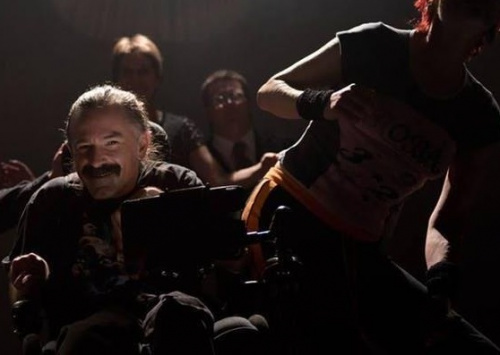THE HISTORY OF DIFFERENT LIGHT
NASDA Theatre, E Block, CPIT, Christchurch
01/08/2019 - 03/08/2019
Christchurch Arts Festival 2019
Production Details
Founded here in Christchurch in 2004, Different Light Theatre brings together the talents and stories of an ensemble of performers with intellectual disabilities.
In The History of Different Light six actors present their own experiences with the company using memories, images, objects, lost properties, forgotten words and wheelchairs flying over the disabled city to show the gaps between worlds and gaps between people. And what a history there is to be shared!
A Different Light has performed in Sydney, Melbourne, San José, California, Leeds and New Zealand. Their performances have been written about in numerous books and academic journals and previous shows include The Poor Dears, Still Lives, A Different Light Wizard of Oz, The Three Ecologies of Different Light, and I belong in the past, and the future, and the very now…
Honest, remarkable and inspiring, join this wondeful cast as they “come out of the past and turn their backs on the present to fly over the city in which we disappear.”
“By turns delightful and thought provoking … something incredibly special” – Erin Harrington Theatreview, reviewing The Wizard of Oz.
NASDA Theatre Ara Institute, E Block, 130 Madras Street, Christchurch Central
Thursday 01 August 7:00pm Buy Tickets
Friday 02 August 7:00pm Buy Tickets
Saturday 03 August 7:00pm Buy Tickets
Conc.$10 –
Full$25 –
Service fees apply.
Theatre , Spoken word , Physical , Multi-discipline ,
Probes the complexity and beauty of the human condition
Review by Erin Harrington 02nd Aug 2019
The Christchurch Arts Festival production of The History of Different Light marks a significant milestone: the 15th anniversary of Christchurch-based mixed ability theatre company Different Light, which is one of the best kept secrets in Aotearoa New Zealand performing arts.
This retrospective production has been devised by long-time members Benjamin ‘Glen’ Burrows, Ben Morris, Josie Noble, Matthew Phelan, Peter Rees and Isaac Tait, under the direction of company founder Tony McCaffery and Sofie Martinsdotter. It is a beautiful tribute to the company’s extraordinary storytelling and creative generosity, as well as its significant status within, and contribution to, disability arts.
The show moves chronologically through some of the company’s highlights, from its first show in 2004 at Hohepa, a residential community for people with intellectual disabilities, through to performances in New Zealand, the USA, the UK and Australia. The company recalls, refigures and re-enacts previous performances, which are often shown through projected images and archival video footage.
This juxtaposition of the past and the present is both a fitting celebration of the company’s work and a moving exploration of history, memory and change. This is prefigured in the piece’s wonderfully tongue-in-cheek opening, in which the performers ‘evolve’ to the sound of Aaron Copeland’s epic ‘Fanfare for the Common Man’. Five of the actors wiggle like amoeba, flop like fish, groom each other like apes and then wander about as distracted, device-wielding contemporary humans, lit dramatically by a powerful torch held by Benjamin / Glen, who cruises around the stage in his hi-tech wheelchair in God mode.
As the show develops, performers who are now (in some cases) much older echo the movements and spoken work of their younger selves, and re-share stories and experiences that have informed earlier devised work. A lot of the material is exquisitely funny. It’s a treat to see footage from shows staged at overseas festivals, but there’s an added pleasure, too, if you’ve seen some of these earlier shows. I had forgotten how powerful the company’s post-quake work, Still Lives, was as the performers muse on the nature of safety and home, and the place of disability in a disabled city.
Presence and absence figures throughout, as does the question of who is included in ‘us’ and ‘them’. In parts, performers who weren’t in individual shows reflect on how they would have performed had they participated. In other instances, we hear about much-loved core company members – John Lambie and Louise Payne – who have passed away, but who still remain a key part of the company’s family and ecology. We end with a reflection on the shootings at Al Noor Mosque; Al Noor, too, means light.
I admit that for most of the performance I have a pretty sizable lump in my throat. It’s a simple show: just the six performers in their street clothes, and a bit of AV operated by McCaffery, for an hour or so in a black box theatre. Nonetheless, I think it does more to probe the complexity and the beauty of the human condition – love, creativity, grief, friendship, anger, generosity, humour, hurt, joy, compassion – than any large-scale spectacle. It also does some powerful social work in reminding us that what we call ‘normal’ is a construction, and just a sliver in the great, beautiful ocean of diverse human experience.
If you want to go to theatre to feel something, and to share different perspectives, then you’d be hard pressed to find something better. The company is a taonga – here’s hoping for another 15 years.
Copyright © in the review belongs to the reviewer







Comments